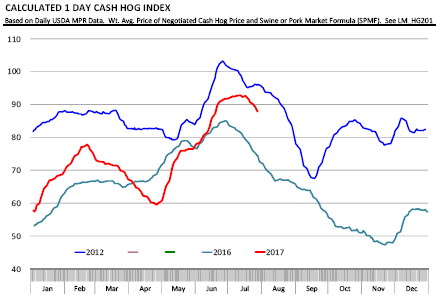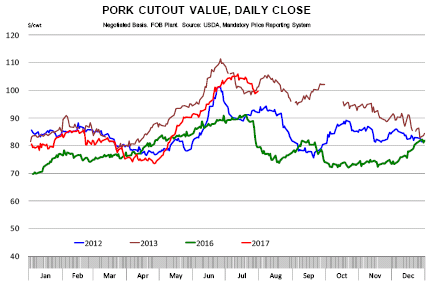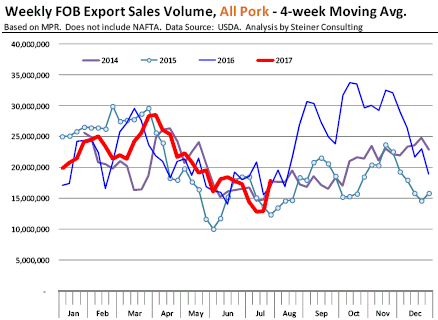



CME: Futures Currently Implying Significant Value Erosion in Pork Cutout
US - Lean hog futures pulled back Monday (31 August) despite gains in the value of the pork cutout and robust pork packer margins, reports Steiner Consulting Group, DLR Division, Inc.The August contract lost the most ground, declining 110 points from the previous day. Our calculations currently peg the 1-day cash hog index at $87.87/cwt, down about $5/cwt from the peak in mid July but still some 21.4 per cent higher than a year ago.

There is currently an almost $8 basis with just two weeks or so until expiration. Futures are currently implying significant value erosion in the cutout but so far we have not seen much to support that. The market is significantly discounted and participants will trade accordingly depending on how trade develops in the next few days. Belly prices remain key.
Despite the recent declines, hog producers and processors continue to benefit from excellent pork demand, both from domestic and export channels. While bellies get much of the press as current values are about double what they were a year ago, other primals have also performed quite well.
The overall value of the pork cutout is now up 25.4 per cent from last year and the difference between the hog and cutout gains has translated in improved meat margins for pork packers. By our last count, the meat margin stood at $11/cwt compared to $7/cwt a year ago.

Keep in mind that the meat margin is a subset of the overall gross packer margin. One needs to also consider the value of pork by-products to get a more complete picture on packer returns. But back to the gains of various primals. The loin primal is up 5 per cent from last year, the picnic primal is up 4 per cent and the ham primal is up 19 per cent from a year ago.
So while ham cold storage stocks may have increased in June, one should not immediately assume that it reflects a slowdown in demand. Exports are a big part of pork sales these days and exports to Asian markets require that product be staged in cold storage before it ships out.
Consequently, higher cold storage stocks may not necessarily imply a weakness in demand, particularly when ham primal values are up significantly compared to a year ago. USDA does provide some insights as to the kind of product that currently is being sold for export. Unfortunately, the data does not include sales to NAFTA markets.
Still, in the context of the discussion above the numbers tell an interesting story. For week ending 28 July, FOB ham sales to export markets outside of North America were 1.463 million pounds, 252 per cent higher than a year ago. And this is not just a one week sale.

For the period 3 June - 28 July, weekly ham export sales outside of NAFTA have averaged 1.7 million pounds per week or a total of 13.9 million pounds for the entire period. This represents an increase of 10.6 million pounds or 326 per cent compared to the same period a year ago. In this context, one can square the reality of both larger cold storage inventories AND higher ham primal values.
One final point concerns recent hog slaughter trends and how well they have matched with the June Hogs and Pigs report. Our assessment is that while hog slaughter is modestly lower than the inventory report implied, it is still close to the market and a useful guidance for late summer/early fall supplies.
If, like us, you track weekly hog slaughter numbers, we would urge you to update those numbers when USDA issues its revisions two weeks later. For the last few months, the weekly hog slaughter data has been revised consistently higher. Since 4 June, total hog slaughter based on the initial weekly hog slaughter estimate has been 12.744 million head while the revised slaughter has been 12.807 million, a 0.5 per cent difference.






